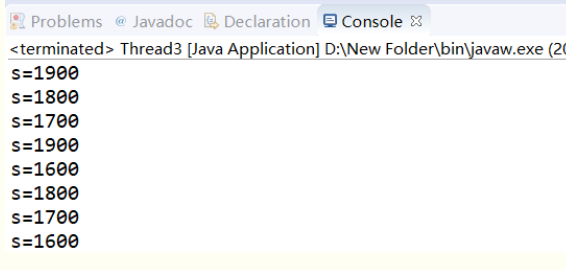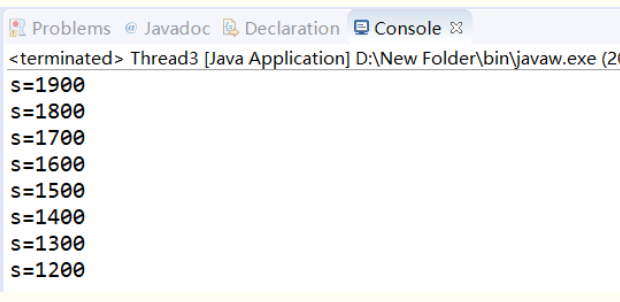201871010128-杨丽霞《面向对象程序设计(java)》第十七周学习总结
|
项目 |
内容 |
|
这个作业属于哪个课程 |
https://www.cnblogs.com/nwnu-daizh/ |
|
这个作业的要求在哪里 |
https://www.cnblogs.com/nwnu-daizh/p/12073034.html |
|
作业学习目标 |
(1) 理解和掌握线程的优先级属性及调度方法; (2) 掌握线程同步的概念及实现技术; (3) Java线程综合编程练习
|
随笔博文正文内容包括:
第一部分:总结线程同步技术(10分)
一、 Java线程调度与优先级
Java提供一个线程调度器来监视和控制Runnable状态的线程。线程的调度策略采用抢占式,优先级高的线程比优先级低的线程优先执行。在优先级相同的情况下,按照“先到先服务”的原则。
每个Java程序都有一个默认的主线程,就是通过JVM启动的第一个线程。对于应用程序,主线程执行的是main()方法。对于Applet主线程是指浏览器加载并执行小应用程序的那一个线程。
子线程是由应用程序创建的线程。
还有一种线程称为守护现成(Daemon),这是一种用于监视其他线程工作的服务线程,优先级为最低。
二、线程同步:
1、使用synchronized关键字 由于java的每个对象都有一个内置锁,当用此关键字修饰方法时, 内置锁会保护整个方法。在调用该方法前,需要获得内置锁,否则就处于阻塞状态。
注: synchronized关键字也可以修饰静态方法,此时如果调用该静态方法,将会锁住整个类。同步是一种高开销的操作,因此应该尽量减少同步的内容。通常没有必要同步整个方法,使用synchronized代码块同步关键代码即可。
同步方法:给一个方法增加synchronized修饰符之后就可以使它成为同步方法,这个方法可以是静态方法和非静态方法,但是不能是抽象类的抽象方法,也不能是接口中的接口方法。
2、wait和notify
wait():使一个线程处于等待状态,并且释放所持有的对象的lock。
sleep():使一个正在运行的线程处于睡眠状态,是一个静态方法,调用此方法要捕捉InterruptedException异常。
notify():唤醒一个处于等待状态的线程,注意的是在调用此方法的时候,并不能确切的唤醒某一个等待状态的线程,而是由JVM确定唤醒哪个线程,而且不是按优先级。
3、Allnotity():唤醒所有处入等待状态的线程,注意并不是给所有唤醒线程一个对象的锁,而是让它们竞争。
使用特殊域变量volatile实现线程同步
a.volatile关键字为域变量的访问提供了一种免锁机制
b.使用volatile修饰域相当于告诉虚拟机该域可能会被其他线程更新
c.因此每次使用该域就要重新计算,而不是使用寄存器中的值
d.volatile不会提供任何原子操作,它也不能用来修饰final类型的变量
三、对象锁也叫方法锁,是针对一个对象实例的,它只在该对象的某个内存位置声明一个标识该对象是否拥有锁,所有它只会锁住当前的对象,而并不会对其他对象实例的锁产生任何影响,不同对象访问同一个被synchronized修饰的方法的时候不会阻塞
创建一个类,synchronized修饰普通方法,即为对象锁,那么这个时候,多个线程访问同一个对象实例的这个方法时,是会同步的,并且只有一个线程执行完,另一个线程才会执行。
java的对象锁和类锁:java的对象锁和类锁在锁的概念上基本上和内置锁是一致的,但是,两个锁实际是有很大的区别的,对象锁是用于对象实例方法,或者一个对象实例上的,类锁是用于类的静态方法或者一个类的class对象上的。我们知道,类的对象实例可以有很多个,但是每个类只有一个class对象,所以不同对象实例的对象锁是互不干扰的,但是每个类只有一个类锁。但是有一点必须注意的是,其实类锁只是一个概念上的东西,并不是真实存在的,它只是用来帮助我们理解锁定实例方法和静态方法的区别的
第二部分:实验部分
实验1:测试程序1(5分)
l 在Elipse环境下调试教材651页程序14-7,结合程序运行结果理解程序;
l 掌握利用锁对象和条件对象实现的多线程同步技术。
package synch; import java.util.*; import java.util.concurrent.locks.*; /** * A bank with a number of bank accounts that uses locks for serializing access. * @version 1.30 2004-08-01 * @author Cay Horstmann */ public class Bank { private final double[] accounts; //存储账户的数组 private Lock bankLock; //属性对象,两个与同步控制的标准类 private Condition sufficientFunds; //条件对象 // /** * Constructs the bank. * @param n the number of accounts * @param initialBalance the initial balance for each account */ public Bank(int n, double initialBalance) //Bank构造器,两个入口参数 { accounts = new double[n]; Arrays.fill(accounts, initialBalance); bankLock = new ReentrantLock(); //构建一个可以被用来保护临界区的可重入锁。 sufficientFunds = bankLock.newCondition(); //返回一个与该锁有关的条件对象 } /** * Transfers money from one account to another. * @param from the account to transfer from * @param to the account to transfer to * @param amount the amount to transfer */ public void transfer(int from, int to, double amount) throws InterruptedException //同行之间的转账操作 { bankLock.lock(); //加锁操作 try { while (accounts[from] < amount) //当账户余额不足时 sufficientFunds.await(); //把该线程放在条件的等待集中,当前线程被阻塞,并且放弃了锁 System.out.print(Thread.currentThread()); accounts[from] -= amount; System.out.printf(" %10.2f from %d to %d", amount, from, to); accounts[to] += amount; System.out.printf(" Total Balance: %10.2f%n", getTotalBalance()); sufficientFunds.signalAll(); //解除全部被阻塞的线程 } finally { bankLock.unlock(); //释放这个锁 } } /** * Gets the sum of all account balances. * @return the total balance */ public double getTotalBalance() //使用了公共资源 { bankLock.lock(); //加锁操作 try { double sum = 0; for (double a : accounts) sum += a; return sum; } finally { bankLock.unlock(); //释放该锁 } } /** * Gets the number of accounts in the bank. * @return the number of accounts */ public int size() { return accounts.length; } }
1 package synch; 2 3 /** 4 * This program shows how multiple threads can safely access a data structure. 5 * @version 1.31 2015-06-21 6 * @author Cay Horstmann 7 */ 8 public class SynchBankTest 9 { //常量的定义 10 public static final int NACCOUNTS = 100; 11 public static final double INITIAL_BALANCE = 1000; 12 public static final double MAX_AMOUNT = 1000; 13 public static final int DELAY = 10; 14 15 public static void main(String[] args) 16 { 17 Bank bank = new Bank(NACCOUNTS, INITIAL_BALANCE); 18 for (int i = 0; i < NACCOUNTS; i++) 19 { 20 int fromAccount = i; 21 Runnable r = () -> { //Runnable接口实现创建线程 22 try 23 { 24 while (true) 25 { 26 int toAccount = (int) (bank.size() * Math.random()); //随机函数产生 27 double amount = MAX_AMOUNT * Math.random(); //随机函数产生MAX_AMOUNT个随机数 28 bank.transfer(fromAccount, toAccount, amount); //调用transfer方法在同行之间进行转账 29 Thread.sleep((int) (DELAY * Math.random())); //随机睡眠时间DELAY 30 } 31 } 32 catch (InterruptedException e) 33 { 34 } 35 }; 36 Thread t = new Thread(r); //创建一个线程 37 t.start(); //该线程开始工作 38 } 39 } 40 }
运行截图:

实验1:测试程序2(5分)
l 在Elipse环境下调试教材655页程序14-8,结合程序运行结果理解程序;
l 掌握synchronized在多线程同步中的应用。
package synch2; import java.util.*; /** * A bank with a number of bank accounts that uses synchronization primitives. * @version 1.30 2004-08-01 * @author Cay Horstmann */ public class Bank { private final double[] accounts; /** * Constructs the bank. * @param n the number of accounts * @param initialBalance the initial balance for each account */ public Bank(int n, double initialBalance) { accounts = new double[n]; Arrays.fill(accounts, initialBalance); } /** * Transfers money from one account to another. * @param from the account to transfer from * @param to the account to transfer to * @param amount the amount to transfer */ public synchronized void transfer(int from, int to, double amount) throws InterruptedException { while (accounts[from] < amount) wait();//在其他线程调用此对象的 notify() 方法或 notifyAll() 方法前,导致当前线程等待 System.out.print(Thread.currentThread()); accounts[from] -= amount; System.out.printf(" %10.2f from %d to %d", amount, from, to); accounts[to] += amount; System.out.printf(" Total Balance: %10.2f%n", getTotalBalance()); notifyAll();//唤醒在此对象监视器上等待的所有线程 } /** * Gets the sum of all account balances. * @return the total balance */ public synchronized double getTotalBalance() { double sum = 0; for (double a : accounts) sum += a; return sum; } /** * Gets the number of accounts in the bank. * @return the number of accounts */ public int size() { return accounts.length; } }
package synch2; /** * This program shows how multiple threads can safely access a data structure, * using synchronized methods. * @version 1.31 2015-06-21 * @author Cay Horstmann */ public class SynchBankTest2 { //常量的定义 public static final int NACCOUNTS = 100; public static final double INITIAL_BALANCE = 1000; public static final double MAX_AMOUNT = 1000; public static final int DELAY = 10; public static void main(String[] args) { Bank bank = new Bank(NACCOUNTS, INITIAL_BALANCE); for (int i = 0; i < NACCOUNTS; i++) { int fromAccount = i; Runnable r = () -> { //Runnable接口创建线程 try { while (true) { int toAccount = (int) (bank.size() * Math.random()); //随机函数 double amount = MAX_AMOUNT * Math.random(); //产生 1000个随机数 bank.transfer(fromAccount, toAccount, amount); //transfer方法在同行之间进行转账 Thread.sleep((int) (DELAY * Math.random())); //随机产生0-10毫秒之间的一个数,调用sleep方法睡眠。 } } catch (InterruptedException e) { } }; Thread t = new Thread(r); //新建一个线程 t.start(); //调用start方法开启线程 } } }
运行截图:

实验1:测试程序3(5分)
l 在Elipse环境下运行以下程序,结合程序运行结果分析程序存在问题;
尝试解决程序中存在问题
1 class Cbank
2 {
3 private static int s=2000;
4 public static void sub(int m)
5 {
6 int temp=s;
7 temp=temp-m;
8 try {
9 Thread.sleep((int)(1000*Math.random()));
10 }
11 catch (InterruptedException e) { }
12 s=temp;
13 System.out.println("s="+s);
14 }
15 }
16
17
18 class Customer extends Thread
19 {
20 public void run()
21 {
22 for( int i=1; i<=4; i++)
23 Cbank.sub(100);
24 }
25 }
26 public class Thread3
27 {
28 public static void main(String args[])
29 {
30 Customer customer1 = new Customer();
31 Customer customer2 = new Customer();
32 customer1.start();
33 customer2.start();
34 }
35 }
运行截图:

修改后代码:
class Cbank { private static int s=2000; public synchronized static void sub(int m) { int temp=s; temp=temp-m; try { Thread.sleep((int)(1000*Math.random())); } catch (InterruptedException e) { } s=temp; System.out.println("s="+s); } } class Customer extends Thread { public void run() { for( int i=1; i<=4; i++) Cbank.sub(100); } } public class Thread3 { public static void main(String args[]) { Customer customer1 = new Customer(); Customer customer2 = new Customer(); customer1.start(); customer2.start(); } }
运行截图:

实验2:结对编程练习包含以下4部分(10分)
利用多线程及同步方法,编写一个程序模拟火车票售票系统,共3个窗口,卖10张票,程序输出结果类似(程序输出不唯一,可以是其他类似结果)。
Thread-0窗口售:第1张票
Thread-0窗口售:第2张票
Thread-1窗口售:第3张票
Thread-2窗口售:第4张票
Thread-2窗口售:第5张票
Thread-1窗口售:第6张票
Thread-0窗口售:第7张票
Thread-2窗口售:第8张票
Thread-1窗口售:第9张票
Thread-0窗口售:第10张票
1) 程序设计思路简述;
火车票售票系统,售票时窗口0、1、2一起工作,利用线程同步技术实现。
2) 符合编程规范的程序代码;
package Test class Ticketsthread implements Runnable { public static final int DELAY = 1000; int t = 1; boolean flag = true; public void run() { while (flag) { try { Thread.sleep((int) (DELAY * Math.random())); } catch (InterruptedException e) { e.printStackTrace(); } synchronized (this) { if (t <= 10) { System.out.println(Thread.currentThread().getName() + "窗口售:第" + t + "張票"); t++; } if (t > 10) { flag = false; } } } } } public class TicketsTest { public static void main(String[] args) { Ticketsthread th = new Ticketsthread(); new Thread(th).start(); new Thread(th).start(); new Thread(th).start(); } }
3)程序运行功能界面截图;

实验总结:(5分)
本周学习了线程技术,了解了多线程并发执行中的问题。多个线程相对执行的顺序是不确定的。线程执行顺序的不确定性会产生执行结果的不确定性。在多线程对共享数据操作时常常会产生这种不确定性。.多线程并发运行不确定性问题解决方案:引入线程同步机制。锁对象与条件对象:用ReentrantLock保护代码块、synchronized关键字、synchronized关键字作用:某个类内方法用synchronized 修饰后,该方 法被称为同步方法; 只要某个线程正在访问同步方法,其他线程 欲要访问同步方法就被阻塞,直至线程从同 步方法返回前唤醒被阻塞线程,其他线程方 可能进入同步方法。